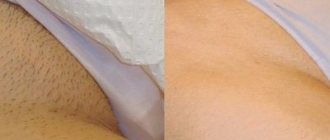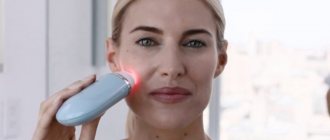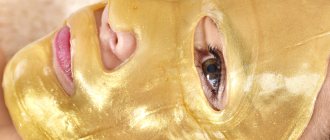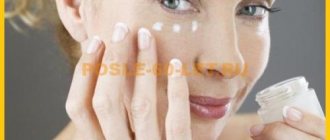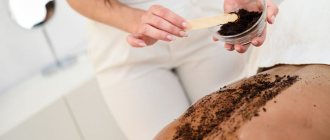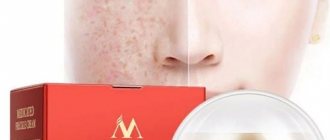There are many ways to lose unnecessary hair on the body, one of which is home photoepilation.
We will talk about the principle of operation of the method, the longevity of the effect and the possibility of application on various areas of the skin.
To properly carry out the hair removal procedure, carefully study the information provided.
Operating principle
Let's start with what this method is and what the effect of photoepilation depends on.
If you have heard about the principle of laser hair removal, then it will be difficult for you to distinguish it from photoepilation, since in both methods the removal of unwanted vegetation is carried out using light waves.
That is, a ray of light hitting the hair causes it to separate from the hair follicle and fall out. The laser also kills the hair follicle, so subsequent hair growth is not observed. Did you know ?
Hair is exposed to laser only at a certain moment of growth, namely: when the hair is 1-2 mm long and connected to the hair follicle, and not just to the walls of the follicle. However, there are many differences that are difficult to explain without going into detail about the entire action.
The first difference is a photoepilation device that emits light with a spectrum from 560 to 1200 nm. This means that several lasers are involved in the work at once. They are capable of removing hair of any color (except gray) from skin of any color.
The second difference is the quality of the procedure. A photoepilator is not able to remove all suitable hairs on the treated area at once. This is due to the operating principle of the laser system itself. Therefore, the number of necessary procedures for complete removal of vegetation almost doubles compared to laser hair removal.
The third difference also applies to photoepilation equipment. Due to the use of a large number of light-emitting elements, the range of action of the epilator increases. That is, the device covers most of the skin at one time, but this is also a disadvantage, which is described in the second paragraph.
The fourth difference (and the main advantage of photoepilation) is the time of the session. Since the work involves many elements that emit light, the duration of the procedure is reduced by 2-3 times compared to laser hair removal.
And the last difference is the price. On average, the price for this procedure is 1.5 times higher than for conventional laser hair removal.
In Europe during the Middle Ages, excess hair on the body was shaved off, and soft hair was rolled out with bread-wax balls.
How to choose the right photoepilator
Let's talk about choosing a device for photoepilation at home. Due to the fact that this procedure in clinics is quite expensive, and the number of procedures involves significant waste, choosing a “home” photoepilator is not only saving money, but also timely getting rid of hair.
Popular brands and approximate prices
When choosing a device for home photoepilation, first of all you need to pay attention to the list of manufacturers, maximum and minimum prices.
Major manufacturers of equipment for home use:
- "Babyliss";
- "Beurer"
- "Braun";
- "Panasonic";
- Philips;
- Remington;
- “Rio Beauty;
- Rowenta;
- "Silk'n"
Of these, two manufacturers can be distinguished that have the largest assortment - BaByliss and Philips.
The price range for hair removal devices is quite wide, so you can choose either the most economical option, which costs $27-30, or the most expensive, which costs $670-700.
Depending on the price, a device for home photoepilation can be portable or powered from the mains, equipped with a cooling system or additional lighting.
Advice !
Portable photoepilators capture a smaller area of skin and discharge quickly enough, so it is not recommended to buy a battery-powered unit unless there is a proper need. The kit may also include attachments for sensitive skin, removal of individual hairs, or for facial hair removal.
Preparatory activities
Photoepilation of the labia majora and bikini area is a complex procedure that requires special preparation. It must be started 2-4 weeks before the start of the session. In summer, hair removal using photoepilation is not recommended. In between procedures, exposure to ultraviolet rays should be avoided. You should take care of smooth skin in winter. Before hair removal, the following steps go through:
- 30 days before the session, they refuse to use an epilator (the skin is treated with a razor);
- stop visiting the solarium and the beach 2 weeks in advance;
- 2-3 days in advance, stop shaving the bikini area (photoepilation is carried out if there is hair at least 2 mm long).
The effectiveness of home appliances on different parts of the body
The effectiveness of photoepilation at home is the main question that interests many girls reading this article.
The fact is that, as in the case of laser hair removal, it is worth considering many factors that affect the effectiveness of the procedure. It all depends not only on the high cost of the device, but also on the settings. You need to choose exactly the radiation interval and the power at which the hairs and hair follicles will be destroyed, and the skin will not be burned.
However, do not be afraid, since device manufacturers have foreseen the possible consequences and made the maximum power of photoepilators such that you cannot cause significant damage to yourself.
Therefore, after reading the instructions in detail, you will be able to compare your hair type with those offered in the catalog and set the settings correctly.
Now let's talk about certain parts of the body on which vegetation most often causes inconvenience.
Advice !
When removing hair from sensitive areas (bikini and face), use special attachments to ensure proper operation of the device. Bikini zones. The effectiveness of photoepilation in the bikini area is quite high, since in this area the skin is naturally very light, and the hairs themselves are quite dark, so the device works very well, removing unnecessary hair. The only thing worth focusing on is the duration of the session.
Since the skin in the bikini area is very thin, prolonged exposure to the laser can lead to burns, so carefully read the instructions for the photoepilator and do not exceed the described time limits.
Deep bikini areas. A deep bikini includes the pubic area and labia minora.
The only difference between deep bikini photoepilation and regular bikini is the number of light flashes required to achieve maximum effect. So, to remove hair around the contour of underwear, 6-30 pulses are enough, and to remove hair from the pubis and labia, you need from 30 to 90 flashes. Advice !
To achieve maximum effect when preparing for a summer trip to the sea, you need to start procedures at the end of winter. On the face. Excessive facial hair is a girl’s worst nightmare, since, unlike other parts of the body, the face cannot be covered with anything, and the maximum effect is expected from the procedure.
The photoepilator perfectly removes hair from the face, but the hair must be 1-2 mm long and not bleached. If these conditions are met, then you only need to carry out a 7-10 minute procedure to begin getting rid of hair.
It is worth remembering that photoepilation will be useless in areas with bleached hair, since they are not exposed to laser irradiation. That is why be careful and do not exceed the time limit for removing such vegetation, otherwise you will either overheat the device or damage the skin.
What is bikini photoepilation
Bikini photoepilation is a procedure during which hair in the intimate area is eliminated by applying a powerful light pulse to the hair shaft and root.
The procedure is carried out using a special device that emits light waves of a certain length. The flow emanating from it is absorbed by melanin, the coloring pigment contained in the hair. Light destroys the stem and bulb from the inside. After 5-7 days, the hair falls out along with the root.
To completely get rid of unwanted vegetation, you need to undergo several sessions. Their number and frequency depend on individual characteristics.
The photoepilation method is considered relatively painless and safe. This is what most cosmetologists recommend for getting rid of hair in the intimate area.
On this topic
- Photoepilation
What are the consequences of photoepilation?
- Irina Nasredinovna Nachoeva
- October 15, 2020
Medical centers and beauty salons offer several types of hair removal in the bikini area:
- Outdoor. The treated area does not exceed the boundaries of underwear.
- Deep. Hair is removed from the inner thighs and pubic area.
- Total (Hollywood). Destruction of hair on the pubis, labia, inner thighs.
In most cases, in addition to the selected type of hair removal, a procedure for removing hair between the buttocks is offered.
Preparation
We will tell you directly about how to do photoepilation at home, and what preparation needs to be done before performing the procedure.
Before hair removal, you need to visit a dermatologist so that he can determine your skin type and decide whether photoepilation can be carried out at the moment or not.
If the doctor gives a positive answer, we move on to the second stage, which involves reducing the hair length to 1-2 mm. To do this, we only use a razor; no other methods of removing vegetation are suitable. In order not to sit with a ruler, measuring the desired length, simply shave the desired part of the skin 1-2 days before the procedure.
After studying and charging the device, we cleanse the skin using a scrub or other products that do not contain abrasive particles (they have increased hardness). Before epilation, the skin must be clean and completely dry. This completes the preparation for photoepilation.
How to do the procedure at home: features of the procedure
Let's look at how to properly do photoepilation at home in step-by-step instructions.
After the preparatory stage, turn on the device and bring it to the skin. The sensors must determine whether the settings are correct for your skin and hair type. If everything is normal, the indicator will light green or blue; if not, it will light red. When removing hair, the epilator must be moved horizontally or at an angle of 45° to achieve maximum effect.
When carrying out the procedure on sensitive areas, you should apply a special photoepilation gel, which diffuses light and reduces pain.
When the allotted time for the treated area is over, the photoepilator will emit a sound signal, after which you need to move the device to another part of the skin or end the procedure.
On average, in 50 pulses the epilator covers an area of 2.5 cm, which is worth considering when moving after a signal.
About the photoepilation procedure, how to do it at home and devices for this type of hair removal, watch this video:
It is worth remembering that for safety reasons you must wear protective glasses for photoepilation, otherwise you can seriously damage your eyesight.
Important !
Epilate away from reflective surfaces (mirror, glass, metal) so that the light beam cannot reach your face, head or eyes. Constantly monitor your sensations during the procedure. You should not feel severe pain or the absence of any irritants at all. In the first case, the beam is too strong, in the second, it is weak. A slight burning sensation, discomfort, sensation of rupture of the follicles in the skin - this is what you should feel during hair removal.
How is the procedure performed?
Designing the bikini area using the classic or Brazilian method of photoepilation includes the following steps:
- Pain relief and skin protection. Special cosmetics are applied to reduce sensitivity and protect against ultraviolet radiation. Sprays and gels help avoid irritation and soothe the skin after hair removal.
- Use of protective equipment. The master and the client put on glasses. The cosmetologist must use medical gloves. The patient's lower abdomen is covered with a protective apron.
- Depilation. A special device is passed over the skin. The device transmits radiation that destroys hair. The recommended number of flashes is 30-90 per session. The frequency and strength of light pulses play an important role. It is quite difficult to get rid of blond hair, so the power of exposure is increased. With increased skin sensitivity, the strength of the impulses is reduced, increasing the frequency of outbreaks.
- Final processing. After completion of the session, the bikini area is wiped with antibacterial wipes. An anti-inflammatory gel is applied to the body. The client is given recommendations on skin care.
Post-procedure care
After the procedure, it is recommended to apply a special cream that will soothe the skin and moisturize it. Next, use sunscreen (if your skin is not covered by clothing) for two weeks.
During the day after photoepilation, you should not take a cold or too hot shower, wear tight-fitting clothes that come into contact with the treated area, or use chemicals.
From the first to the last procedure (until the entire course is completed), you cannot go to the solarium, sunbathe on the beach, or remove hair in any other way (except with a razor).
If, after photoepilation, severe redness of the skin or burning sensation is observed, then Panthenol or other preparations for burns should be used.
Important !
Any cosmetics that are applied to the skin area during the entire course should not contain alcohol. It is worth adding that after photoepilation at home, you need to clean the device used of fat, cooling gel or hair. Pay attention to the life of the lamps used to produce the light beam. They have a short service life and require frequent replacement.
Possible side effects and consequences
Many people believe that photoepilation is harmful. This opinion is not unfounded. During the procedure, powerful light radiation is used, which can cause the following consequences:
- Burns. Minor injuries almost always occur. Burns manifest as redness and soreness of the skin in intimate areas. Symptoms last for several days. Burns occur due to an individual skin reaction or the use of a device with too high a power. Panthenol cream helps cope with irritation. Severe burns during hair removal are extremely rare.
- Visual impairment. This side effect occurs when safety rules are not followed. Performing the procedure without wearing safety glasses is prohibited. If a photoepilation session is carried out correctly, it is almost impossible to harm the visual organs.
- Hyperpigmentation of treated skin areas. Occurs with prolonged exposure to ultraviolet rays. Therefore, cosmetologists do not recommend doing photoepilation in the summer. After the session, defects in the form of dark spots appear in the bikini area.
How many sessions will it take?
The average number of sessions required to obtain a stable effect is 5-6. However, the procedures must be carried out strictly after a certain period of time, so that at the time of removal the hair is at the desired stage of growth.
Therefore, answering the question of how often photoepilation should be done during one course, it is worth citing statistical data: the procedure must be repeated every 3-4 weeks in order to destroy those 30% of hair that are ready for removal.
It is worth remembering that a second course of hair removal will need to be carried out after 7-8 months, otherwise the hair will gradually return.
Photoepilation was invented by Morgan Gusgavsson. In 1990, at a congress of dermatologists in Stockholm, a Swedish doctor and engineer told the world about his discovery - the possibility of using intense pulsating light technology in cosmetology.
Advantages and disadvantages
The advantages of photoepilation include:
- can be used for hair removal in both men and women;
- use for treating leather of any type;
- possibility of hair removal over large areas;
- no risk of infection;
- low risk of ingrown hairs;
- long lasting effect.
The procedure also has its disadvantages, which include:
- the presence of restrictions on hair color (gray, blond and red hair under the influence of light is not always destroyed);
- the possibility of complications;
- high cost of the session;
- presence of contraindications.
Contraindications
Contraindications to photoepilation are similar to contraindications to laser hair removal.
Here is the most complete list of contraindications:
- age under 18 years (due to hormonal levels);
- diabetes;
- diseases of the cardiovascular system;
- phlebeurysm;
- herpes, dermatitis and other skin diseases;
- skin damage (abrasions, scratches, wounds, burns);
- the presence of a large number of moles and birthmarks in the treatment area;
- pregnancy;
- period after prolonged exposure to the sun or solarium;
- while taking steroids;
- porphyrin disease or allergy to sunlight.
All these contraindications must be observed, otherwise you will harm your health or not get the expected effect.
It is worth noting that the age limit is not associated with a threat to health, but with the futility of use, since during puberty, hair growth and the appearance of new hair follicles accelerate.
Contraindications to the procedure
Contraindications to photoepilation, which can cause negative consequences, are the following temporary conditions:
- presence of tanning on the treated area;
- mechanical and thermal damage to the skin (cuts, abrasions, burns);
- allergic reactions;
- dermatitis of various nature;
- herpes;
- period of pregnancy and lactation;
- the use of medications that increase the sensitivity of the epidermis to light.
After eliminating these factors, photoepilation becomes possible. But there are diseases that place a taboo on this procedure.
